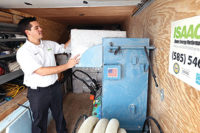Green and What It Means
Green at the HVACR manufacturer level starts with a manufacturer’s approach to the environment. Daikin McQuay’s Don Winter, vice president — marketing, said that for Daikin McQuay, “‘green HVACR’ is a commitment to applying environmentally friendly practices in all aspects of our business operations. … We continually strive to make improvements to our equipment as well as our environmental management system through complying with all applicable environment legislation and regulations; identifying further ways to prevent pollution, reduce waste, and conserve natural resources; and measuring and monitoring our progress toward minimizing our environmental impact.”
Making improvements to units translates to designing equipment with energy efficiency and energy conservation in mind, which also benefits the end user’s bottom line.
“Speaking from a manufacturer’s perspective, ‘green HVACR’ means that we’re able to develop equipment that produces air more efficiently, ultimately conserving energy and saving customers money on their utility bills,” said Erich Bauman, commercial product manager, Rheem,
Heating & Cooling Division.
But to some, green is more than the HVAC system’s energy efficiency and energy conservation; it ties in with other systems to create a better building.
“Green heating, ventilation, air conditioning, and refrigeration solutions are energy conservation measures focused on energy and operational efficiency and sustainability. These measures represent a major step in transforming an organization’s facilities into high performance buildings that tie to its organizational mission. High performance buildings take a whole-building approach to performance while creating spaces that are reliable, safe, healthy, comfortable, and efficient,” said Chris Hsieh, LEED AP BD+C, senior systems engineer, Trane, a brand of Ingersoll Rand.
In pursuit of green HVACR, manufacturers have been making products in recent years with technologies and features to enable better energy efficiency. One of these technologies — variable-speed technology — can save energy at part load.
“Standard commercial units have constant volume supply fans. They run one high speed during all modes of operation — whether or not maximum airflow is required, ultimately wasting costly, valuable energy. Variable-speed technology reduces airflow by 50 percent during first-stage cooling and for fan-only operation, which saves energy and improves comfort when maximum airflow is not required,” said Bauman. He also listed smarter diagnostic technologies and more efficient building materials as features that “the most efficient commercial HVAC equipment includes.”
Hsieh also pointed out another trend he sees — measurement. “The HVACR industry is slowly recognizing the importance of the whole life-cycle impact [of a piece of equipment] on the environment.”
Customers
But in the end, producing green HVACR equipment doesn’t matter if end users don’t purchase or lease them, but customers are making an investment in green these days. James Dagley, LEED AP, vice president, channel marketing & strategy, Johnson Controls Inc., said, “Every year, we [Johnson Controls] conduct the global Energy Efficiency Indicator (EEI), a survey of more than 3,400 global executives and building owners responsible for energy management and investment decisions in industrial, commercial, and public sector buildings. This year, 96 percent reported undertaking at least one improvement action in the last 12 months. The most common actions taken were lighting upgrades (69 percent), HVAC or controls improvements (61 percent), and water efficiency actions (50 percent).”
While green HVAC equipment is being installed both in new construction and retrofit applications, much more activity is occurring on the retrofit side. Though, as Winter commented, “Retrofit buildings are ‘going green’ when it makes economical sense.”
Making sense financially may, in some cases, be linked to having more appeal to potential tenants as well as cutting the operating costs. Dagley pointed out, “In the commercial sector, building owners are looking for ways to reduce costs, increase the value of their real estate portfolio, and attract new tenants. … The 2012 EEI found that nearly one-quarter of all respondents were willing to pay a premium for tenant space in a certified green building.” He also gave the Empire State Building as a recent green retrofit success story. “Just one year after an innovative building retrofit project, the Empire State Building is ahead of plan and has exceeded its year one energy-efficiency guarantee by 5 percent, saving $2.4 million and attracting new, high-profile tenants like the owners and operators of the social media outlet LinkedIn.”
View From the Field
At the contractor level, part of what green HVACR involves, besides methods that the company follows, whether it’s refrigerant reclamation, recycling items taken from the jobsite, or following LEED requirements, is keeping up on new products and technologies, “and knowing when new options that make good sense for customers become available. For example, this year we’ve seen some great new thermostats with Wi-Fi capacity become available. This allows commercial plant managers to track several thermostats, even off-site, in real time,” said Robert Helbing, Air-Tro Inc., Monrovia, Calif.
Both Helbing and Ellis G. Guiles Jr., PE, LEED AP, HERS Rater, Green Rater, vice president of TAG Mechanical Systems Inc., Syracuse, N.Y., are not seeing that commercial customers are going green to be green, but rather to save greenbacks. “Commercial customers are always looking for ways to control costs. Green systems save money, provided that the installation cost isn’t excessive,” said Helbing.
Guiles remarked that commercial “customers aren’t asking for green HVACR,” but are asking for help to “1) lower their energy costs, 2) improve their indoor environments, 3) keep their operating costs in check, and 4) in some cases, get their HVACR systems operating and performing correctly because they simply aren’t or never have.”
Factors that can sway a customer to install green HVACR are utility and/or governmental financial incentives that are offered in the customer’s area. “In some cases, availability of incentives (tax credits, grants, low interest loans, etc.) can encourage an owner to proceed with improvements and upgrades when they may not have. This is especially true in the category of 5,000-square-foot to 100,000-square-foot buildings, as many of these buildings are owned by ‘small’ business owners who may be or are being squeezed by current economic conditions.”
The burden of being aware of and dealing with these incentives is falling on the HVACR contractor, according to Helbing. “Commercial customers expect us to keep up with any federal, local, or utility rebate programs. They know the programs are out there, but prefer to rely on us to manage the thicket of paperwork such programs involve.”
Another motivating factor in choosing, or not, green HVACR equipment is the initial cost of new equipment versus payback and what entity owns the building.
Said Guiles, “First costs are still the driver in most new construction projects. Payback and/or life-cycle costs become part of the conversation in existing buildings looking to replace or upgrade equipment or lower current operating and utility costs. It’s still difficult, at least in central New York state, to get customers to think long term (i.e., more than three years out, and in some cases even a shorter amount of time) when it comes to their facilities. Of course, even this depends on the owner (government vs. private, hospitals or schools vs. retail, etc.).
Helbing stated that making green investments and whether to focus on the initial cost or payback (the longer view) in a facility is greatly impacted by whether or not the occupant also owns the building or not.
“When a building is on a triple-net lease, the tenant pays for all repairs, equipment replacement, and electric bills. Those tenants, who might be on a lease with a remaining term under five years, are reluctant to invest a penny more than necessary in someone else’s building. The owner, meanwhile, doesn’t pay the utility bill, and so also is reluctant to invest in energy upgrades. You’re much better off if the business owns the building. That gives them the long view you’re hoping for.”
He continued, “If the payback period is shorter than the remaining lease term, you’re good. Or if you can install equipment that itself is leased, and the lease payment is lower than the energy savings, then you’re good, too. Otherwise, paybacks of more than five years become hard to sell.”
Publication date: 9/24/2012










